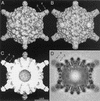An antibody to the putative aphid recognition site on cucumber mosaic virus recognizes pentons but not hexons
- PMID: 12414964
- PMCID: PMC136911
- DOI: 10.1128/jvi.76.23.12250-12258.2002
An antibody to the putative aphid recognition site on cucumber mosaic virus recognizes pentons but not hexons
Abstract
Cucumber mosaic virus (CMV), the type member of the genus Cucumovirus (family Bromoviridae), is transmitted by aphids in a nonpersistent manner. Mutagenesis experiments identified the betaH-betaI loop of the capsid subunit as a potential key motif responsible for interactions with the insect vector. To further examine the functional characteristics of this motif, we generated monoclonal antibodies that bound to native virions but not to betaH-betaI mutants. Fab fragments from these antibodies were complexed with wild-type CMV and the virus-Fab structure was determined to 12-A resolution by using electron cryomicroscopy and image reconstruction techniques. The electron density attributed to the bound antibody has a turret-like appearance and protrudes from each of the 12 fivefold axes of the icosahedral virus. Thus, the antibody binds only to the pentameric clusters (pentons) of A subunits of the T=3 quasisymmetric virus and does not appear to bind to any of the B and C subunits that occur as hexameric clusters (hexons) at the threefold (quasi-sixfold) axes. Modeling and electron density comparisons were used to analyze the paratope-epitope interface and demonstrated that the antibody binds to three betaH-betaI loops in three adjacent A subunits in each penton. This antibody can discriminate between A and B/C subunits even though the betaH-betaI loop adopts the same structure in all 180 capsid subunits and is therefore recognizing differences in subunit arrangements. Antibodies with such character have potential use as probes of viral assembly. Our results may provide an additional rationale for designing synthetic vaccines by using symmetrical viral particles.
Figures







Similar articles
-
Characterization of an Indian isolate of cucumber mosaic virus infecting Egyptian henbane (Hyoscyamus muticus L.).Acta Virol. 2000 Jun-Aug;44(3):131-6. Acta Virol. 2000. PMID: 11155354
-
A non-persistently transmitted-virus induces a pull-push strategy in its aphid vector to optimize transmission and spread.Virus Res. 2014 Jun 24;186:38-46. doi: 10.1016/j.virusres.2013.12.012. Epub 2013 Dec 26. Virus Res. 2014. PMID: 24373951
-
Epitope presentation system based on cucumber mosaic virus coat protein expressed from a potato virus X-based vector.Arch Virol. 2006 Jul;151(7):1373-86. doi: 10.1007/s00705-005-0711-x. Epub 2006 Feb 20. Arch Virol. 2006. PMID: 16489509
-
Cucumber mosaic virus: viral genes as virulence determinants.Mol Plant Pathol. 2012 Apr;13(3):217-25. doi: 10.1111/j.1364-3703.2011.00749.x. Epub 2011 Oct 7. Mol Plant Pathol. 2012. PMID: 21980997 Free PMC article. Review.
-
Molecular Modeling for Better Understanding of Cucumovirus Pathology.Adv Virus Res. 2018;102:59-88. doi: 10.1016/bs.aivir.2018.06.002. Epub 2018 Jul 26. Adv Virus Res. 2018. PMID: 30266176 Review.
Cited by
-
Nonneutralizing human rhinovirus serotype 2-specific monoclonal antibody 2G2 attaches to the region that undergoes the most dramatic changes upon release of the viral RNA.J Virol. 2006 Dec;80(24):12398-401. doi: 10.1128/JVI.01399-06. Epub 2006 Sep 27. J Virol. 2006. PMID: 17005641 Free PMC article.
-
Discrimination among rhinovirus serotypes for a variant ICAM-1 receptor molecule.J Virol. 2004 Sep;78(18):10034-44. doi: 10.1128/JVI.78.18.10034-10044.2004. J Virol. 2004. PMID: 15331736 Free PMC article.
-
Interaction of alphaVbeta3 and alphaVbeta6 integrins with human parechovirus 1.J Virol. 2010 Sep;84(17):8509-19. doi: 10.1128/JVI.02176-09. Epub 2010 Jun 16. J Virol. 2010. PMID: 20554778 Free PMC article.
-
Structure of Fusarium poae virus 1 shows conserved and variable elements of partitivirus capsids and evolutionary relationships to picobirnavirus.J Struct Biol. 2010 Dec;172(3):363-71. doi: 10.1016/j.jsb.2010.06.022. Epub 2010 Jul 3. J Struct Biol. 2010. PMID: 20599510 Free PMC article.
-
The phage L capsid decoration protein has a novel OB-fold and an unusual capsid binding strategy.Elife. 2019 Apr 4;8:e45345. doi: 10.7554/eLife.45345. Elife. 2019. PMID: 30945633 Free PMC article.
References
-
- Bailey, S. 1994. The CCP4 suite: programs for protein crystallography. Acta Crystallogr. D 50:760-763. - PubMed
-
- Baker, T. S., and R. H. Cheng. 1996. A model-based approach for determining orientations of biological macromolecules imaged by cryoelectron microscopy. J. Struct. Biol. 116:120-130. - PubMed
-
- Booy, F. P., R. B. S. Roden, H. L. Greenstone, J. T. Schiller, and B. L. Trus. 1998. Two antibodies that neutralize papillomavirus by different mechanisms show distinct binding patterns at 13 Å resolution. J. Mol. Biol. 281:95-106. - PubMed
-
- Burke, K. L., G. Dunn, M. Ferguson, P. Minor, and J. W. Almond. 1988. Antigen chimeras of poliovirus as potential vaccines. Nature 332:81-82. - PubMed
Publication types
MeSH terms
Substances
Grants and funding
LinkOut - more resources
Full Text Sources

